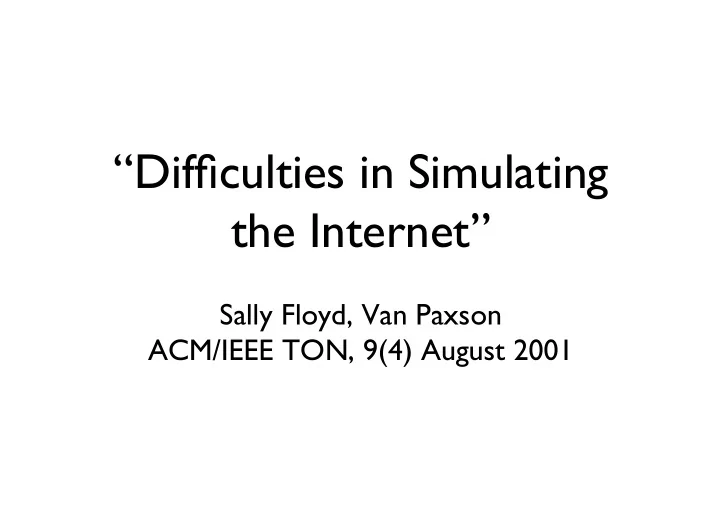

“Difficulties in Simulating the Internet” Sally Floyd, Van Paxson ACM/IEEE TON, 9(4) August 2001
Techniques for Networking Research
Measurement V. Paxson. "End-to-end Internet packet dynamics,” J. Padhye, V. Firoiu, D. Towesley, and J. Kurose "Modeling TCP Throughput: A Simple Model and its Empirical Validation,”
“Reality Check” Are our assumptions reasonable? Is our mathematical model a good estimation of the real world?
e.g., from Paxson’s study 1. packet losses are busrty 2. OTT != RTT/2
Experimentation e.g., V. Jacobson. “Congestion Control and Avoidance"
Deal with implementation issues Sometimes unforseen complexities (e.g. own research experience in Unreliable TCP)
Understand the Behavior of Systems Some systems are too complex to understand with “thought experiments” alone.
Analysis D. Chiu and R. Jain, "Analysis of the increase and decrease algorithms for congestion avoidance in computer networks,” J. Padhye, V. Firoiu, D. Towesley, and J. Kurose "Modeling TCP Throughput: A Simple Model and its Empirical Validation,”
Explore with Complete Control We can understand the basic forces that affect the system. e.g. TCP throughput is inversely propotional to √p
Simplify complex systems If too simplified, important behavior could be missed (TCP throughput without timeout)
Simulation K. Fall and S. Floyd, "Simulation-based comparison of Tahoe, Reno, and SACK TCP," S. Floyd, K. Fall, "Promoting the Use of End-to-End Congestion Control in the Internet,” S. Floyd, V. Jacobson, "Random Early Detection Gateways for Congestion Avoidance,"
Check Correctness of Analysis If simulation uses the same assumptions/model as the analysis, this simply verify the correctness of the mathematical derivations.
Check Correctness of Analysis Simulation can relax some assumptions, use more complex models, etc. to test the limits of analysis. (Real measurement/experiments still needed to check the usefulness of analysis results)
Explore Complex Systems Some systems are too difficult/impossible to analyzed e.g. Internet
Helps Develop Intuition
Measurement } Real World Experimentation Analysis } Abstract Model Simulation
Why is Internet hard to simulate?
1 Internet is diverse
End-hosts : phones, desktops, servers, iPod, Wii
Links : Ethernet, WiFi, Satellite, Dial-up, 3G
Transport : TCP variants, UDP, DCCP
Applications : games, videos, web, ftp, bittorrent
2 Internet is huge
3 Internet is changing
http://www.isc.org/ds/
http://www.dtc.umn.edu/mints/
Median File Transfer Time Size March 1998 10.9 kB December 1998 5.6 kB December 1999 10.9 kB June 2000 62 kB November 2000 10 kB Measurement at LBNL: Statistical property of Internet changes as well.
Why is Internet hard to simulate? 1. Heterogeneous 2. Huge 3. Changing
Suppose you come up with the greatest BitTorrent improvement ever..
You want to simulate it to make sure it works before you release it (and call the press)
What Internet topology should you use in your simulation? How end hosts are connected? What are the properties of the links?
Topology changes constantly Companies keep info secrets Routes may change Routes may be asymmetric
You will need to simulate over a wide range of connectivity and link properties
Suppose you come up with the greatest TCP optimization ever..
You want to know if it is fair to existing TCP versions before you write your SIGCOMM paper..
Which TCP versions to compare with?
Using “fingerprinting”, 831 different TCP implementations and versions are identified.
Which to use? Which to ignore?
What applications to run? What type of traffic to generate? Telnet? FTP? Web? BitTorrent? Skype?
How congested should the network be?
Example from Sally Floyd: RED vs DropTail
Example from Sally Floyd: Using TFRC for VoIP
We can focus our simulation on dominant technology/application today..
TCP: NewReno SACKS OS: Windows Linux Applications: Web, FTP
What about tomorrow?
WiMax? Sensors? Virtual World? DCCP?
10 years ago, you came up with a router mechanism to improve TCP Reno.. No one cares today.
How to verify the simulator itself?
So, how?
Looking for Invariants
1. Diurnal Patterns
hour #constrained ---- ------------ 00 139 2.5% -----------------------------------------------------X 01 144 2.6% ------------------------------------------------------X 02 146 2.6% -------------------------------------------------------X 03 140 2.5% -----------------------------------------------------X 04 119 2.1% ---------------------------------------------X 05 89 1.6% ----------------------------------X 06 69 1.2% --------------------------X 07 55 1.0% ---------------------X 08 45 0.8% -----------------X 09 40 0.7% ---------------X 10 40 0.7% ---------------X 11 42 0.8% ----------------X 12 51 0.9% -------------------X 13 57 1.0% ---------------------X 14 68 1.2% --------------------------X 15 75 1.3% ----------------------------X 16 77 1.4% -----------------------------X 17 92 1.6% -----------------------------------X 18 98 1.8% -------------------------------------X 19 105 1.9% ----------------------------------------X 20 108 1.9% -----------------------------------------X 21 113 2.0% -------------------------------------------X 22 124 2.2% -----------------------------------------------X 23 134 2.4% ---------------------------------------------------X U Waterloo Data 24 Oct 2007
2. Self-Similar Traffic
The traffic is bursty regardless of time scale
Wikipedia
3. Poisson Session Arrival
Remote logins, starting FTP, beginning of web surfing etc.
(so are dead light bulbs, spelling mistakes, etc.)
4. Log-normal Duration
5. Heavy Tail Distributions
Self-Similarity in World Wide Web Traffic: Evidence and Possible Causes, by Mark E. Crovella and Azer Bestavros
1. Looking for Invariants
2. Explore Parameter Space
Change one parameter, fix the rest
Explore a wide range of values
3. Use Traces
e.g. collects traces of web sessions, video files, VoIP traffic
Use it to simulate the traffic source
But must be careful about traffic shaping and user/application adaptation.
e.g. traces collected during non- congested time should not be use to simulate congested networks.
4. publish simulator script for others to verify
Conclusion
Simulation is useful but needs to do it properly
Be careful about your simulation model: you want it to be as simple as possible, but not simpler.
Be careful about your conclusion: “A is 13.5% better than B” is probably useless.
“A is 13.5% better than B under these environment” is better but not general
Not really for quantitative results, but more for
understanding the dynamics, illustrate a point, explore unexpected behavior.
Recommend
More recommend